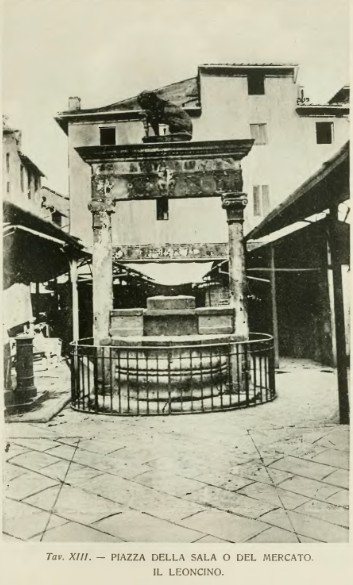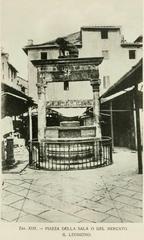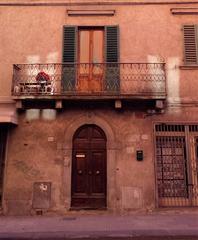
Pozzo del Leoncino: Visiting Hours, Tickets, and the Ultimate Guide to Pistoia’s Historic Well
Date: 14/06/2025
Introduction
Nestled in the heart of Pistoia’s vibrant historic center, the Pozzo del Leoncino—“Well of the Little Lion”—stands as a remarkable symbol of the city’s medieval roots and Renaissance artistry. Situated in the lively Piazza della Sala, this iconic well has served the community for centuries, providing water to merchants and residents while embodying the city’s civic pride and political legacy. Today, it remains an essential destination for history enthusiasts, architecture admirers, and travelers eager to immerse themselves in authentic Tuscan culture.
This guide offers a comprehensive overview of the Pozzo del Leoncino: its history, architectural features, cultural significance, practical visitor information—including hours, ticketing, accessibility—and tips for exploring nearby attractions in Pistoia’s historic center.
Table of Contents
- Historical Background
- Visiting Pozzo del Leoncino
- Frequently Asked Questions (FAQ)
- Cultural Significance
- Visitor Experience
- Conclusion and Visitor Tips
- Sources
Historical Background
Origins and Medieval Development
The Pozzo del Leoncino is located in Piazza della Sala, one of Pistoia’s oldest and most storied public spaces. Dating back to the Lombard period (6th–8th centuries CE), the piazza was once the site of the Gastaldo’s palace, the administrative center for the king’s local representative (vivipistoia.it). As the city grew during the Middle Ages, the square evolved into the central marketplace, bustling with wooden stalls and merchants. The well became indispensable, supplying water to support both daily life and the thriving market activity.
Architectural Features and Symbolism
Constructed primarily in the 15th century, the Pozzo del Leoncino exemplifies Tuscan stonework and Renaissance aesthetics. Its structure features a circular marble basin, alternating bands of white Carrara and green Prato marble, and two slender Ionic columns supporting an architrave. Atop this architrave sits the “leoncino,” a small sandstone lion added in 1529 to symbolize Florentine dominance over Pistoia (Tuscany Planet). The lion’s paw rests on the city’s coat of arms, asserting both strength and local identity.
The well’s design harmonizes with Pistoia’s Romanesque architectural tradition, its decorative elements echoing those found in the nearby Cathedral and Baptistery. Subtle geometric motifs and incised lines further enrich its visual appeal, while the weathered stone testifies to centuries of communal use.
Modern Preservation
During World War II, the well suffered damage but was carefully restored in 1954. Temporary modern market structures were removed to return the well to its historic prominence (vivipistoia.it). Today, the Pozzo del Leoncino is maintained by city authorities as a cherished civic monument.
Visiting Pozzo del Leoncino
Hours and Tickets
Visiting Hours:
The Pozzo del Leoncino is an open-air monument in a public piazza, accessible year-round, 24 hours a day. There are no restricted hours for visiting the well.
Tickets:
No ticket or entry fee is required to visit the Pozzo del Leoncino. The site is freely accessible to all, making it an ideal stop for travelers exploring Pistoia.
Accessibility
Piazza della Sala is pedestrian-friendly and generally accessible for visitors with mobility impairments. The flat, paved surface provides easy access to the well. However, some adjacent medieval streets are narrow and cobbled, so comfortable footwear is recommended.
Travel Tips
- Best Times to Visit: Early mornings (especially during the daily market from 8:00 AM to 1:00 PM, Monday–Saturday) and late afternoons offer a vibrant or tranquil atmosphere, respectively.
- Photography: Soft natural light in the morning or evening best highlights the well’s intricate details.
- Amenities: The piazza is surrounded by cafes, restaurants, and artisan shops. Public restrooms are available nearby.
- Reaching the Well: Pistoia is easily accessible by train from Florence and other Tuscan cities. The well is a short walk from the main train station, following signs to the city center.
Nearby Attractions
- Pistoia Cathedral (San Zeno): A Romanesque masterpiece located in nearby Piazza del Duomo.
- Museo Civico di Pistoia: Showcasing Pistoia’s art and history.
- Palazzo dei Vescovi: An architectural landmark with panoramic city views.
- Piazza degli Ortaggi: Lively with shops, eateries, and local markets.
Guided Tours and Events
Guided walking tours of Pistoia’s historical center frequently include the Pozzo del Leoncino. Seasonal festivals and food fairs in Piazza della Sala offer a festive backdrop for your visit. For tour schedules and event information, consult the official Pistoia tourism website.
Frequently Asked Questions (FAQ)
Q: Is there an entrance fee to visit the Pozzo del Leoncino?
A: No, the well is in a public square and is free to visit at any time.
Q: What are the best times to visit?
A: Early mornings and late afternoons provide ideal conditions for photography and experiencing the piazza’s atmosphere.
Q: Is the site wheelchair accessible?
A: Yes, the piazza is flat and accessible, though some surrounding cobbled streets may be challenging.
Q: Are guided tours available?
A: Yes, many local operators and tourism offices offer guided walks that include the Pozzo del Leoncino.
Q: Are there nearby amenities?
A: Yes, the area offers cafes, restaurants, shops, and public restrooms.
Cultural Significance
The Pozzo del Leoncino is more than just a historic well—it is a living symbol of Pistoia’s communal spirit and resilience. The lion statue atop the well, emblematic of both the city’s autonomy and a reminder of Florentine rule, encapsulates the complexities of local identity. The piazza’s trade-named streets—Via del Cacio, Via dei Fabbri—reflect the enduring connection to centuries of craftsmanship and market activity (vivipistoia.it).
Visitor Experience
Visiting the Pozzo del Leoncino immerses you in the daily rhythms of Pistoia. The morning market fills Piazza della Sala with vibrant energy, echoing the square’s historical role as the city’s commercial heart (Italy Time). Local festivals and evening gatherings at nearby trattorias and wine bars create a convivial atmosphere where history and contemporary life blend seamlessly.
The well itself, with its harmonious proportions and iconic lion sculpture, is a favorite subject for photographers and artists. Plaques and guidebooks provide context for independent travelers, while guided tours enrich your understanding of the site’s layered past.
Conclusion and Visitor Tips
The Pozzo del Leoncino remains one of Pistoia’s most evocative landmarks, anchoring the social and commercial life of Piazza della Sala. Its history as a vital water source, its Renaissance symbolism, and its enduring role in local culture make it an unmissable destination for anyone exploring Tuscany.
Visitor Tips:
- Combine your visit with a stroll through the morning market or an evening aperitivo at a local cafe.
- For in-depth historical context, join a guided walking tour.
- Take advantage of the free and open access to enjoy the well at your own pace.
- For up-to-date event information and interactive maps, consult the official Pistoia tourism website and consider downloading the Audiala app.
Embrace the charm and history of Pozzo del Leoncino to make your trip to Pistoia truly unforgettable.
Sources
- Pozzo del Leoncino in Pistoia: Visiting Hours, History, and Tips for Visitors, 2025, vivipistoia.it (http://www.vivipistoia.it/visitare/piazza-della-sala-pistoia/)
- Visiting Pozzo del Leoncino in Pistoia: History, Architecture, and Practical Visitor Information, 2025, Tuscany Planet (https://tuscanyplanet.com/pistoia/)
- Visiting Pozzo del Leoncino in Pistoia: Hours, Tickets, and Historical Significance, 2025, Visit Pistoia (https://www.visitpistoia.eu/en/)
- Pozzo del Leoncino Visiting Hours, Tickets, and Visitor Guide to Pistoia’s Historical Well, 2025, Visit Tuscany (https://www.visittuscany.com/fr/idees/10-choses-a-faire-a-pistoia/)
- Italy Time - Pistoia, 2025 (https://italytime.net/pistoia/)

